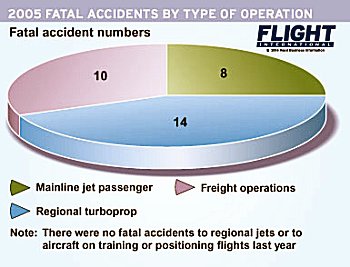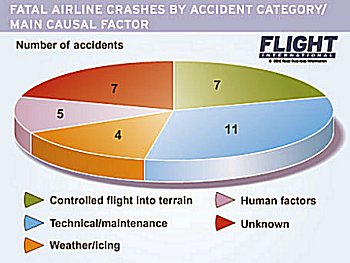Airline safety in 2005 took a step backwards to the late 20th century in terms of the number of fatal accidents and resulting passenger and crew deaths wordwide. It was a disappointing 12 months given the outstanding safety performance in the previous two years.
The Flight Safety Foundation’s (FSF) technical programmes director Jim Burin assesses 2005 as an “average” year, observing that “the historic leading killers in aviation – CFIT [controlled flight into terrain] and loss of control – have made an unwelcome comeback, resulting in a higher number of fatalities than we have seen recently”. More optimistically, given the FSF’s year of work on the approach and landing accident reduction (ALAR) programme, he adds: “We are showing signs of reducing the risk of approach and landing accidents, although we need to ensure this is a trend and not a one-year event.”

Until 2004 the figures for fatal accidents, fatalities and hull losses had all shown a consistent decline (see bar chart), but 2005 has, at least temporarily, reversed that, showing 34 accidents and 1,050 fatalities. These figures, however, are close to or slightly better than the annual averages for the past 10 years (see chart).

There were several common factors in the major fatal accidents in 2005, however, especially those involving jet airliners: they involved airlines based in countries that have a mediocre or poor safety record compared with the world average; and almost all the states of registration of these crashed aircraft have struggling economies (see accident listings) which usually means that safety oversight is low on the political priorities list.
Statistics show that, for two decades or more, airlines in Africa and in parts of Latin America and Asia – were responsible for a small percentage of the world’s air transport activity and a large percentage of its serious accidents, according to International Civil Aviation Organisation records.
Another significant factor in the 2005 safety scene was the continuing absence of fatal accidents involving major world airlines or the latest generation of airliners – those with fly-by-wire control systems or state-of-the-art flightdecks. Older jets that were written off in last year’s fatal accidents included four Boeing 737-200s, a 737-300, a 707, an MD-82, a McDonnell Douglas DC-9-30, and three Ilyushin Il-76s. Meanwhile, the world has lost another nine veteran Antonov turboprop types to fatal accidents.
Pressurisation problem
 The Helios 737-300 that crashed in Greece was one of the intermediate generation of jets, with a part digital, part electro-mechanical flightdeck. This configuration, however, seems unlikely to be relevant to the accident cause. Early reports from the investigator suggest the accident sequence began when the flightcrew failed to set the pressurisation controls correctly during pre-start checks, and this omission was compounded by their failure to recognise warnings that the cabin was not pressurising as the aircraft climbed. Chief investigator Akrivos Tsolakis looks likely to comment, however, on the fact that many other incidents of failure to pressurise have occurred in 737s, but in those cases crews recognised the warnings in time.
The Helios 737-300 that crashed in Greece was one of the intermediate generation of jets, with a part digital, part electro-mechanical flightdeck. This configuration, however, seems unlikely to be relevant to the accident cause. Early reports from the investigator suggest the accident sequence began when the flightcrew failed to set the pressurisation controls correctly during pre-start checks, and this omission was compounded by their failure to recognise warnings that the cabin was not pressurising as the aircraft climbed. Chief investigator Akrivos Tsolakis looks likely to comment, however, on the fact that many other incidents of failure to pressurise have occurred in 737s, but in those cases crews recognised the warnings in time.
Two latest-generation aircraft suffered serious runway overruns last year, each of them operated by major carriers. Both were the victims of decisions to land in marginal weather with tailwinds. When an Air France Airbus A340 landing at Toronto Pearson airport overran the runway into a shallow ravine it was destroyed by fire, but all the passengers and crew escaped with their lives.
In the Southwest incident, involving a 737-700 at Chicago Midway, all the passengers and crew escaped unharmed, but a child was killed in a car hit by the aircraft when it crashed through the perimeter fence on to a major road. Although the aircraft was badly damaged it is likely to be repaired, according to AvSoft, which notes that a Next Generation 737 has never been written off.
The world’s safety problems are becoming ever more clearly regionalised and related to ageing technology. The International Air Transport Association has recognised this with its Focus on Africa programme, into which IATA is putting more resources, according to the organisation’s senior vice-president safety, operations and infrastructure Gunther Matschnigg. Africa may be the region with the most dramatic need for attention, but it is not the only one.
DAVID LEARMOUNT/LONDON
Accidents/incidents in 2005 (PDF)
Industry pressures for safety During December the International Air Transport Association took an unexpected step that will almost certainly accelerate the industry’s attempts to whip into line airlines in nations with lower safety standards. The established IATA Operational Safety Audit (IOSA) is going to become a condition for IATA membership within two years. Airlines that fail the IOSA will lose their membership status. IOSA was originally designed as a voluntary audit, although IATA pitched it for approval by major aviation agencies like the US Federal Aviation Administration (it is FAA-recognised) to use as a tool for checking the operational standards of an airline or its foreign codeshare partners. |
Source: Flight International























